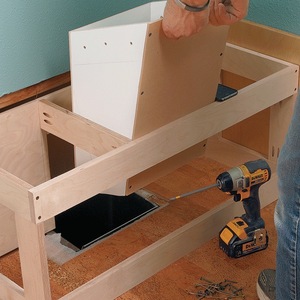Hey Yall- Merry Christmas. I have a shop area in my basement. I want to build a dust collection system with at least three permanent inlets-table saw, miter saw, and router table, and I would like to have at least one portable hose to use for miscellaneous bench-work. More ports if I can afford it.
I am in the early stages of planning. I will not be running a furniture factory down there, but at times I will be churning out a respectable amount of dust. If possible, I would like to locate the vacuum itself outside the shop, underneath a side porch. it would be out of the weather, but still outside the house. The most convenient setup for me would be to route the shavings and dust directly outside into a special area of the flower bed, from which it could be composted or removed, and so skip the step of emptying out or removing a dust bag.
I am trolling for ideas for how to accomplish this. Has anyone here custom built their own system? What is the best source of components? Any Ideas for homeaid ducts? shutoff valves? What types of vacuum motors are there? I want something that is powerful, but I can’t go nuts with the checkbook.
Any ideas links or comments would be greatly appreciated.


















Replies
Several of the general woodworking magazines over the past couple of years have had fairly comprehensive articles on designing and building home shop dust systems. If you have a decent library within driving distance, it might be worthwhile to look them over.
In the meantime, perhaps these can get you started:
http://www.woodweb.com/knowledge_base/Dust_Collection_Design_Guide.html
http://www.studio1304.com/silca/cyclone/
This is for systems that are more high powered than what you want, but you find it worth reading:
http://home.att.net/~dustventinc/dvinformation/choose_a_dust_collection_system.htm
A couple of book suggetions:
http://www.growinglifestyle.com/prod/156158116X.html
http://www.amazon.com/exec/obidos/tg/detail/-/0963582127/102-7796654-7035328?v=glance
http://www.mymall.ws/Affiliates.d/Woodworking.d/Tools.d/rockler.d/articles.d/dust.1.html
Edited 12/24/2003 11:42:49 PM ET by CaseyR
Recently finished installing a 2 HP Oneida in my basement shop I'm doing.
Haven't been able to use it yet because the inspector flunked me on the rough mechanical inspection (he comes back in another week or so for the reinspection).
I set mine up similarly to what you have planned, but with the collector inside while venting outside. The similiarity lies in the extraction of inside air going outside - LARGE quantities of the stuff! Creating the possible down/backdraft of combustion products problem.
This method of installation requires adequate makeup air - in such quantities so as not to affect other combustion devices at all. Furthermore, your shop should be sealed as tightly as possible from the rest of the living space so as to avoid any type of pressure drop outside of that shop.
My Oneida sucks 900 CFM of indoor air. I've had a tough time getting someone to help me figure the make-up size considering the pressurized exhaust. Finally, what I've done is to provide 5 times as much makeup size for the exhaust size. Normally the inspector tells me they look for twice the makeup size for HWH and furnances as the vent. I fugure this high pressurized volume needs extra to keep from affecting the furnace on the other side of the wall.
Finding a suitable spot for this venting without making the doublewide too trashy, I ran up thru the stud bays by cutting out large holes in the bottom plate and covering the inside wall with that foil covered bubble wrap insulation. This channel then went up a coupla of feet, thru the exterior wall via a damper into the bottom of a wide bumped out window structure, and then venting to the bottom, out of view.
Solving this problem of the makeup air ended up costing me quite a bit both directly as well as indirectly. Depending upon your planning, you may do better. And of course, I haven't even made mention of the energy issues involved.
I believe the manufacturers are quite aware of this problem and try to push you to venting into the same space via filters. Accordingly, the problem goes away. But my wife would have bobbitized me if I were to get any dust in the house. I had to go the other way.
Recognize that air sealing your shop is also a very expensive method to go. I put in exterior frames for the doors because of the weatherstripping componet.
Buy that book from the Taunton store, Wood Shop Dust Control. It will cover all of your questions as well as some you haven't even thought of asking yet. At the same time, buy yourself some books on workshop design. It's a great project.
Good Luck.
I built a collection system last year. Used a Delta 2-bag unit. I built a cyclone collector just ahead of the blower. Made a plywood box big enough to hold a standard metal trash can with a hinged door on the front. The cyclone drops the dust into the can and you just wheel it outside. Very minimal amount of mess involved. I have only had to empty the actual cloth bags once. Very fine dust goes in the bags. All the shavings and most of the dust drops in the can. I used 4 inch round metal dust for most of the ductwork. Bought commercial blast gates (only about $6 if you shop around). The whole thing including pipe and collector and cyclone cost me around $300. If you put your collector outside, you might want 6 inch duct running to the first machine. I have about 10 feet of duct running to the first machine and the pressure drop is noticeable. If you build your own blower, you'll need at least a good 1 HP motor. Preferably bigger. My blower is 1 1/2 horse and I think it is barely adequate. Would be OK if right next to the machine, but after 15 feet of ductwork it is nowhere near as strong. Grizzly has a lot of the parts and some blowers that are reasonably priced. My system has 6 ports and a maximum run of about 20 feet. If I did it over, I'd go with 6 inch ductwork.
I found a few plans for cyclones on the internet. All required making a big cylinder from sheet metal. I used a small galvanized trash can instead. Built the cone part and the collector box from scrap plywood and caulked all the joints. Works fine.
For your smaller dia. runs carpet tubes (heavy cardboard) works great and is free.
Take a look over at Knots, search there.Also Bill's cyclone and Dust collection site run by Bill Pense.Also Penn State cyclones.Spend the time researching it is really worthwhile. Happy Holidays
1) the only way to get direct discharge is to have all the waste go through the impellers - while that is the way that basic systems are delivered, virtually everyone puts some sort of capture container before the impeller (even the cyclone lids you can buy to fit a garbage can work remarkably well). If direct discharge still sounds good to you (i.e. you remove the bags and have the stuff just pour out): stop and think about dust - 'nuff said.
2) discharging outside has many implications about how to get return air into the house. Even poorly installed home-vacuum systems have been know to suck air back down chimneys and furnace flues ! After you get the volumes right, you have to think about installing a heat exchanger so you don't waste all that furnace heat/air-conditioner cold.
3) and more important than anything else, make sure every inch of duct is properly grounded and continuously linked (including to the chip-producing machine).
Phill Giles
The Unionville Woodwright
Unionville, Ontario
Thanks guys- Good points and good leads.
Phil- I should have specified that this system is actually all outside the house's conditioned envelope. It really isn't a basement, it is more like a ventilated garage- I have a low country style home with parking underneath. The shop is ventilated to the ouside as well. I hadn't considered make-up air since Ii wouldnt need it- but does this mean that the dust collection ducts etc all need to be within a sealed room for max dust control efficiency? If this is the case then I need to re-think, and go back and carefully air seal the underside of the house (the shop ceiling) What do you think?
No, I didn't consider it might be an unconditioned space - if it's free open to outside air, then that's not a consideration; but, you will quickly null the effects of any heat source you're using (air in has to equal air out, and even my little system displaces about 1200 cfm, and that's about a 10x15 room every minute).
I have seen systems used in garages, IMHO it's really no longer a dust-control system as much as a vacuum cleaner for saw-dust and chips, and it will do that very well. An interesting observation (and remember, my sample size is quite low) these garage systems took a lot of dust out of the air; but, seemed to also draw an awfull lot of airborn dirt from the outside that settles inside the shop (in a sealed system, the common practice is to draw outside air through a filter, usually a furnace or automotive filter in the intake duct - filters for deisel engines work great). So, off-the-cuff without seeing the space, I wouldn't bother sealing the space; but, I'd probably put in filtered return air system to lessen the outside dust intrusion.
.
Phill Giles
The Unionville Woodwright
Unionville, Ontario
Edited 12/25/2003 1:24:55 PM ET by Phill Giles
Unfortunately, I have packed away all my woodworking mags, so I can't give you any names and numbers, but a couple of the mags in the past two years or so have, in addition to articles on the dust collection systems, have had articles on building your own dust filter that runs separately from the dust collection system. They are basically just fans in a box with good quality furnace filters to continuously filter out the fine particles.
Another thing I remember from one of the comprehensive articles is that they recommended that you not use air conditioning duct elbows as they are too short a radius. They recommend getting the real dust collection long sweep 90s and 45s.
There was a researched article some time back on the effects of static electricity during the running of the dust collection system. The author measured the effects on a home system and said the fears of a dust explosion from highly overrated in a home system. None the less, I will probably ground my system when I put it in.
Another reported danger that hasn't been researched as well is when small metal filings are sucked up into the dust collection system. Some claim that the oxidation of fine steel filings can generate enough heat to ignite sawdust in the collection containers. It sounds reasonable, but I have not heard anything from the real world as to whether it really is a problem.
Saw a carpenter sharpen a chisel with a belt sander once. Set the dust collection bag on fire. Is that real world?
I'm like you, in that I'll ground my system if it ever gets built. My old crapsman shop vac with plastic wand and the spiral wire hose creates enough static electricty to arc when it grounds to me. I have also seen saw dust standing up like hair on the hose of a friends Delta single stage dust collector. I would ground it, just so I don't get zapped everytime I touch it.
Dave
The smaller blowers like mine have very limited capacity through the impeller. When they say dust collector, they do mean DUST. Mine clogged up in 9 seconds with planer shavings. That's why I built the cyclone unit. If you're not going to have a collector, make sure the blower is big enough to handle chips without clogging up.
Although I did make all my ductwork metal and it is grounded, I have heard mixed opinions about the issue. Some say its essential and some say plastic or other insulating ductwork without ground or bleeder wires are just fine. I prefer the metal.
Sawdust in the garden is a bad idea. I did it once, and my college roommate, who is now a farmer, said it's such a bad thing to do that I should rake as much of it back up as I could. He explained that when wood decomposes, it draws nitrogen from the soil. Sawdust is the worst because it decomposes so fast. So, you'll have to find something else to do with it other than putting it in the garden.
Ohoh....
Who ever invented work didn't know how to fish....
Don't worry about the saw dust in the garden . That is if you keep it in a pile just add grass clippings and a bag of Urea fertilizerevery now and then. Wood takes a lot of Nitrogen to decompose . After it has turned to soil you can put it any place on your garden with out any problems.